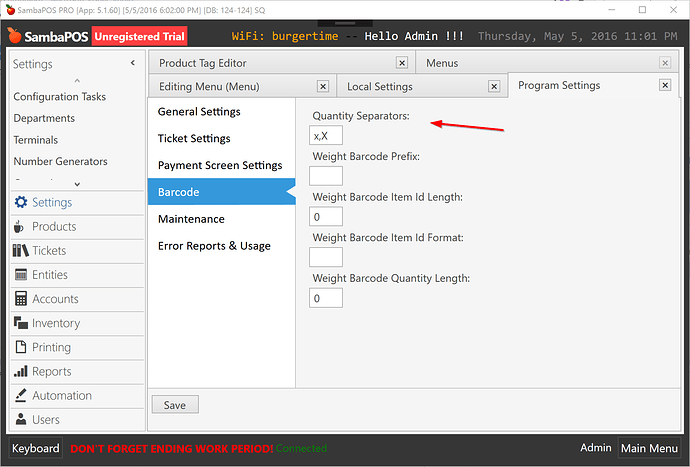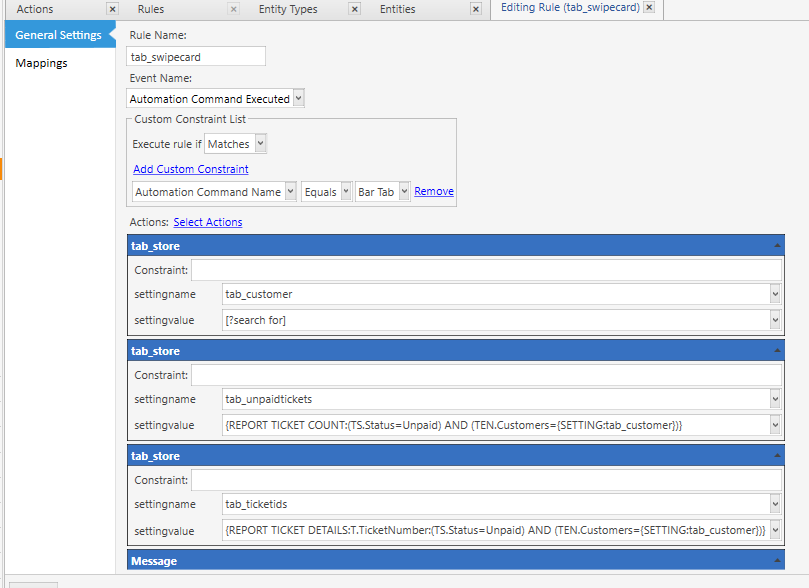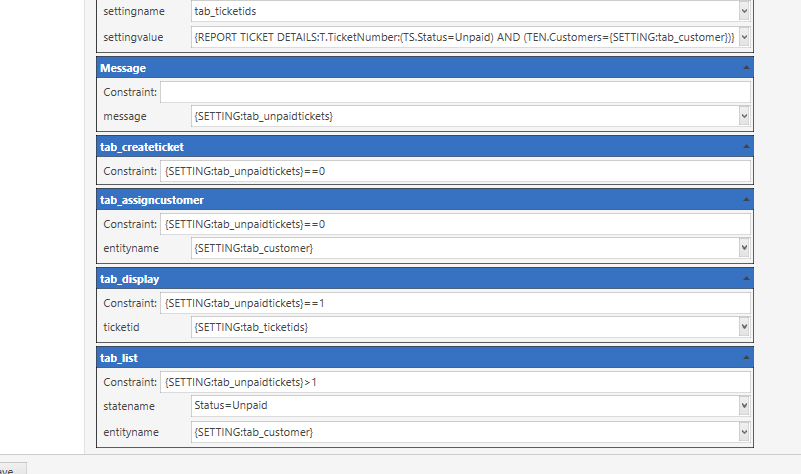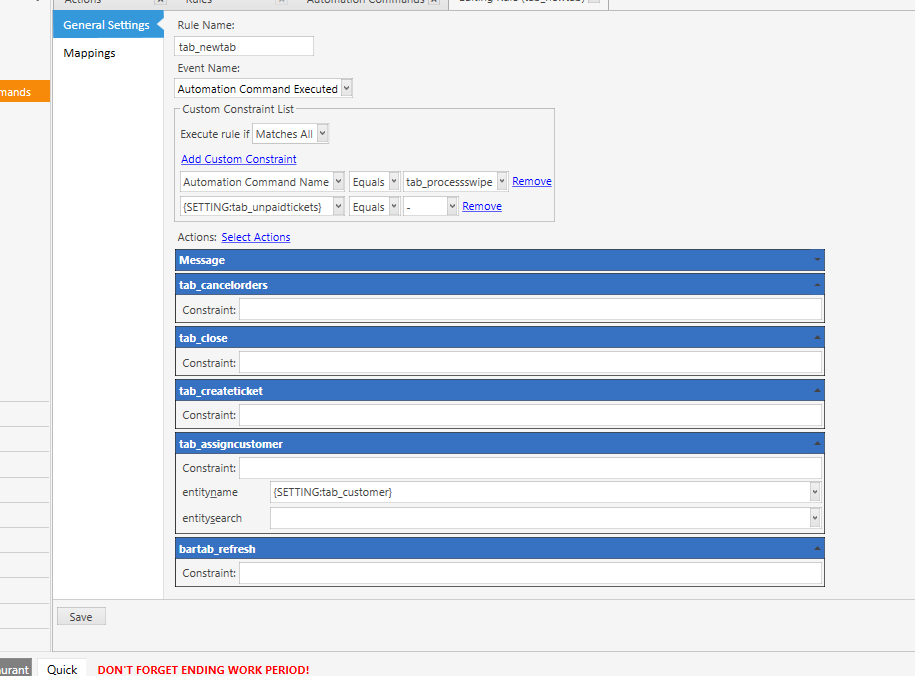Sorry for hiding it there but you can use that setting to change that special character to something else.
Well there you have it @royh, you can change the character from x to whatever. @emre, can we just leave that setting blank if it is something we don’t use that feature/functionality?
Thanks @emre! Much appreciated.
Cheers!
I’m implementing this into our bar.
Is there any functionality in which we can load all tickets tied to the customer entity or the first ticket?
I would like for our bartender to reswipe the card to go to the ticket screen, ticket list, or payment screen for when they close out the ticket. We keep cards with our bar tabs and this makes sense, however I’ve been unable to find an action which will support this.
Thanks,
JCR
@QMcKay any idea on this?
I’m gone as far to store ticket ID in a program setting at ticket closing. This seems to work slightly, however it would be better if the swipe:
(1) Checked for any status=unpaid under the customer name
(2) Show a ticket list of said tickets
(3) If ticket status!=unpaid under customer name, open a new ticket and change the customer entity
I’m only able to pull up last ticket right now and I’m having difficulty with using a single rule to constrain the rules that choose between display ticket and change ticket entity.
Thanks for any help,
JCR
There are Actions for all of those things.
Display Ticket
Display Ticket List
Display Payment Screen
You need to look at the parameters of each of those Actions to see what they support by way of filtering.
-
You swipe the card and the Entity is known.
-
Use a Report Tag to get a count of Unpaid Tickets based on the Entity and store that in a Program Setting.
-
Use a Report Tag to get a list of Unpaid Tickets based on the Entity. Have the Report return only Ticket Id(s), and store that in a Program Setting.
-
Check the Ticket Count Program Setting:
-
if there are 0 Tickets, use Create Ticket Action to create a new Ticket with the Entity assigned to it.
-
if there is only 1 Ticket, use Display Ticket Action to display the Ticket using the Ticket Id from the list (the list will contain a single Id).
-
if there is more than 1 Ticket, use Display Ticket List Action to show all Tickets having a State of Unpaid and filtered by the Entity Name
.
Thanks for the input. I’ll work on it tonight.
JCR
I’m pretty far. I have:
(1) Ticket count reporting correctly
(2) Ticket list/ticket ID working
Whats not working:
(1) Action constraints (I feels like nothing constrains)
Results from the ticket count: True result = ticket numbers, False results = “-”. I’ve tried every combination to constraint the actions.
(2) Ticket list doesn’t seem to display a ticket list
Any ideas on the constraints and the ticket list?
Thanks,
Joe
You need to split it into 2 Rules. In the first Rule, set the Program Settings that do not need Constraining. Fire the rest of the Actions in a second Rule.
You cannot set Program Settings and then use them as Constraints in the Actions that follow. This is because all Action Constraints are evaluated at once when the Rule is triggered. That is, the Program Settings used in the Constraints could be empty, or could be retaining a value from the last time the Rule was run.
So you need an Execute Automation Command Action after all the Program Settings, and in the Rule for that ExecAMC, your Constraints will work for the Actions contained therein.
Thanks @QMcKay. I thought it might be something to that effect. It seemed like the constraints would work intermittently. I’ll take care of this again tonight.
JCR
Opening a tab or tab list is working fine, but I’m unable to open a new ticket and assign the customer entity. There seems to be something not working as I would expect. I should add that I’ve added different actions trying to get it function. I originally though I could get away with, cancel orders, close ticket, change ticket entity, but I’ve been trying anyway possible. Here’s the flow and result:
(1) Inside a customer with multiple tickets: a new ticket is created, however no customer entity shows on the ticket even though the ticket is refreshed. When closing a ticket the new customer does show up under Customer Tickets with no orders on it.
(2) Inside a customer with a single active ticket: a new ticket is created, customer does not show assigned on ticket. Then when closing the new ticket shows under Customer Tickets and the ticket that I was in does not show under customer tickets, but can be located under the ticket lister.
I’ve tried many variations and can’t see to figure it out.
After rearranging, still can’t get Change Ticket Entity to work within the same process which closes a current ticket.

@Jesse Hey Jesse. I think maybe I have to change this flow and just have another automation for open tab, but I haven’t heard anything on it.
I think I’ve narrowed it down. I can’t seem to:
close ticket -> new ticket -> change ticket entity
or
close ticket -> change ticket entity
the change ticket entity doesn’t seem to work.
Any ideas?
JCR
Sorry but I can’t understand what your trying to do.
It might not make a difference, but confidence of this type of thing bothers me:
'{SETTING:tab_unpaidtickets}'!='-'
Strive to explicitly use the TN() function when you are comparing numbers. Non-numeric strings such as '-' will return 0 always, so do this instead:
[=TN('{SETTING:tab_unpaidtickets}')] != 0
… and …
[=TN('{SETTING:tab_unpaidtickets}')] == 0



